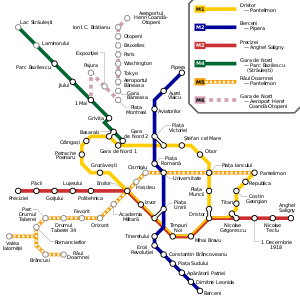Bucharest Metro
 | |||
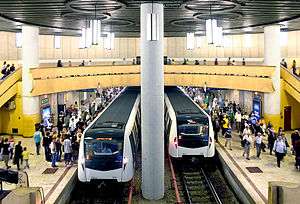 Metro trains at Piata Victoriei | |||
| Overview | |||
|---|---|---|---|
| Native name | Metroul București | ||
| Locale | Bucharest, Romania | ||
| Transit type | Rapid transit | ||
| Number of lines |
4[1] (1 under construction, 1 planned) | ||
| Number of stations |
52[1] (10 under construction, 24 planned)[2] | ||
| Daily ridership | 475,287 (2014)[3] | ||
| Annual ridership | 173,479,646 (2014)[4] | ||
| Operation | |||
| Began operation | 16 November 1979[5] | ||
| Operator(s) | Metrorex | ||
| Number of vehicles | 498 cars | ||
| Train length | 4 and 6 car trains | ||
| Technical | |||
| System length |
71.35 km (44.3 mi)[1] 7.2 km (4.5 mi) under construction | ||
| Track gauge | 1,432 mm (4 ft 8 3⁄8 in)[1] | ||
| Electrification | Third rail 750 V DC | ||
| Top speed | 85 km/h (53 mph) | ||
| |||
The Bucharest Metro (Romanian: Metroul București) is an underground rapid transit system that serves the capital of Romania, Bucharest. It first opened for service on 19 November 1979.[5] The network is run by Metrorex. One of two parts of the larger Bucharest public transport network, Metrorex has an average of approximately 500,000 passenger trips per weekday, compared to the 2,650,000 daily riders on Bucharest's RATB transit system.[3] In total, the Metrorex system is 71.35 kilometres (44.3 mi) long and has 47 stations.[1]
| Transport in Romania |
|---|
| Companies |
History

The first proposals for a metro system in Bucharest were made in the early part of the 20th century, by the Romanian engineers Dimitrie Leonida and Elie Radu.[6]
The earliest plans for a Bucharest Metro were drafted in the late 1930s, alongside the general plans for urban modernization of the city.[7] The outbreak of World War II, followed by periods of political tensions culminating with the installation of communism, put an end to the plans.[8]
By 1970, the public transport system (ITB) was no longer adequate due to the fast pace of urban development, although the system was the fourth-largest in Europe. A commission was set up, and its conclusion pointed to the necessity of an underground transit system that would become the Bucharest Metro. The construction on the new metro system started on 20 September 1975.[9]
The network was not built in the same style as other Eastern European systems.[6] Firstly, the design of the stations on the initial lines was simple, clean-cut modern, without excessive additions such as mosaics, awkward lighting sources or excessive decoration. The main function of the stations was speed of transit and practicality. Secondly, the trainsets themselves were all constructed in Romania and did not follow the Eastern European style of construction.[10] Each station usually followed a colour theme (generally white – in Unirii 2, Universitate, Victoriei 1, Lujerului; red - in Politehnica but also light blue – in Obor and Gara de Nord; orange – in Tineretului; green - in Grozăvești), and an open plan. No station was made to look exactly like any other. Despite this, many stations are rather dark, due to the policies of energy economy in the late 1980s, with later modernisations doing little to fix this problem. Bucharest being one of the largest cities in the region, the network is larger than those of Prague or Budapest. When the planned new line-extensions are finished, they will increase the system length to more than 100 km, with about 80 stations.
The first line, M1, opened on 16 November 1979, running from Semănătoarea (now Petrache Poenaru) to Timpuri Noi.[5] It was 8.1-kilometre (5.0 mi) long with 6 stations.[5] Following this, more lines were opened:[10][11]
- 28 December 1981: M1 Timpuri Noi – Republica; 9.2 kilometres (5.7 mi), 6 stations
- 19 August 1983: M1 (now M3) Branch line Eroilor – Industriilor (now Preciziei) ; 8.2 kilometres (5.1 mi), 4 stations (Gorjului added later)
- 22 December 1984: M1 Semănătoarea (Petrache Poenaru) – Crângaşi; 0.97 kilometres (0.60 mi), 1 station
- 24 January 1986: M2 Piaţa Unirii – Depoul IMGB (now Berceni) ; 9.96 kilometres (6.19 mi), 6 stations (Tineretului and Constantin Brâncoveanu added later)
- 6 April 1986: M2 Tineretului; 0.0 km, 1 station
- 24 October 1987: M2 Piaţa Unirii – Pipera; 8.72 kilometres (5.42 mi), 5 stations (Piaţa Romană added later)
- 24 December 1987: M1 Crângaşi – Gara de Nord 1; 2.83 kilometres (1.76 mi), 1 station (Basarab added later)
- 28 November 1988: M2 Piaţa Romană; 0.0 km, 1 station
- 5 December 1988: M2 Constantin Brâncoveanu; 0.0 km, 1 station
- 17 August 1989: M3 (now M1) Gara de Nord 1 – Dristor 2; 7.8 kilometres (4.8 mi), 6 stations
- May 1991: M1 Republica – Pantelimon; 1.43 kilometres (0.89 mi), 1 station (single track, operational on a special schedule)
- 26 August 1992: M1 Basarab; 0.0 km, 1 station
- 31 August 1994: M3 Gorjului; 0.0 km, 1 station (westbound platform only; eastbound platform opened in 1998)
- 1 March 2000: M4 Gara de Nord 2 – 1 Mai; 3.6 kilometres (2.2 mi), 4 stations
- 19 November 2008: M3 branch Nicolae Grigorescu 2 – Linia de Centură (now Anghel Saligny), 4.75 kilometres (2.95 mi), 4 stations
- 1 July 2011: M4 1 Mai – Parc Bazilescu, 2.62 kilometres (1.63 mi), 2 stations
- 31 March 2017: M4 Parc Bazilescu – Lac Străulești, 2.1 kilometres (1.3 mi), 2 stations
Lines M1 and M3 have been sharing the section between Eroilor and Nicolae Grigorescu.
Large stations which connect with other lines (such as Victoriei) have two terminals, and each terminal goes by a different name (Victoriei 1 and Victoriei 2). On the official network map, they are shown as two stations with a connection in between, even though, in practice (and in trip planners), they are really only one station with platforms at different levels. There is one exception: Gara de Nord 1 and Gara de Nord 2 are separate stations (although linked through a subterranean passage, the traveller is required to exit the station proper and pay for a new fare at the other station, thus leaving the system), passengers being required to change trains at Basarab.
Generally, the underground stations feature large interiors.[9] The largest one, Piata Unirii, is cathedral-like, with vast interior spaces, hosting retail outlets and fast-food restaurants and has an intricate network of underground corridors and passageways.
Metrorex
Metrorex is the Romanian company which runs the Bucharest Metro. It is fully owned by the Romanian Government through the Ministry of Transportation. There were plans to merge the underground and overground transportation systems into one authority subordinated to the City of Bucharest, however these plans did not come to fruition.
Infrastructure and Network
As of 2011, the entire network runs underground, except for a short stretch between Dimitrie Leonida and Berceni stations on the southern end of M2 line. The network is served by four depots, 2 being located above ground (IMGB and Industriilor) and two underground (Ciurel and Pantelimon) and by additional smaller works at Gara de Nord and Eroilor stations.
There are two connections between the Metro network and the Romanian Railways network, one at Berceni (connecting to the Bucharest Belt Ring), the other at Ciurel (connecting via an underground passage to the Cotroceni-Militari industrial railway). The latter connection however is unused and mothballed. The metro network and the national rail network share the same track gauge (1,435 mm/4 ft 8 1⁄2 in) and loading gauge but not the same electrification system (the metro uses 750 V DC whereas the Romanian Railways use 25,000 V 50 Hz AC) making it possible for new metro cars to be transported cross country as unpowered railway cars.
The network is powered by a bottom-contact third rail system except in works, depots and some tunnels where a catenary system is employed.
Lines
There are 4 metro lines in operation, 1 under construction, and another 1 in the planning phase:
| # | Opened | Current track | U/C track | Planned track | Off-peak frequency[1] | Rush hour frequency[1] |
|---|---|---|---|---|---|---|
| M1 | 1979 | 44.3 km | 0 km | 0 km | 8 minutes (4 minutes between Eroilor and Nicolae Grigorescu) | 6–7 minutes (3–3.5 minutes between Eroilor and Nicolae Grigorescu) |
| M3 | 1983 | 0 km | 0 km | |||
| M2 | 1986 | 18.7 km | 0 km | 0 km | 9 minutes | 3–5 minutes |
| M4 | 2000 | 8.3 km | 0 km | 0 km | 10 minutes | 7 minutes |
| M5 | Q1 2019 (est.) | 0 km | 7.2 km | 11.5 km | - | - |
| M6 | ~2022 (est.) | 0 km | 0 km | 14.2 km | - | - |
| Total: | 71.3 km | 7.2 km | 25.7 km |
- M1 Line: between Dristor and Pantelimon – the first line to open (in 1979). It is circular with a North-Eastern spur. Part of its tracks are shared with M3 (7 stations).
- M2 Line: between Pipera and Berceni opened in 1986, completed in 1988; Runs in a North-South direction, crossing the center.
- M3 Line: between Preciziei and Anghel Saligny opened in 1983, completed in 2008; Runs in an East-West direction, south of the center. Shares part of its tracks with M1 (7 stations).
- M4 Line: between Gara de Nord and Lac Străulești opened in 2000, completed in 2017.
Signalling system
There are multiple signalling systems used. Line 2, the first one that has been modernized, uses Bombardier's Automatic Train Control system. It ensures the protection (Automatic Train Protection) and operation (Automatic train operation) of the new Bombardier Movia trains.
The system uses an IPU (Interlocking processing unit), TI21-M track circuits and EbiScreen workstations. Signals have been kept only in areas where points are present, but only use a white light, meaning that the route has been assigned and the driver can use cab signalling. Trains are usually operated automatically, with the driver only opening and closing the doors and supervising the operation. Other features include auto turnback and a balise system, called PSM (precision stop marker). This ensures that the train can stop at the platform automatically.
On line 3, the ATC system has been merged with the Indusi system. Signals are present in point areas and platform ends. Along with the three red-yellow-green lights, the white ATP light has been added. Optical routes can be assigned, meaning that a train gets a green light (permission to pass the signal) only after the next signal has been passed by the train ahead, or a yellow light, meaning that the signal can be passed at low speed. Automatic Block signals have been removed.
Line 4 uses ATC Dimetronic.
Line 5 is expected to use Bombardier's Automatic Train Control system.
Hours of operation
Trains run from 5 AM to 11 PM, every day. The last trains on M1, M2 and M3 wait for the transfer of the passengers between lines to complete, before leaving Piața Unirii station.[12]
Headway
At rush hour, trains run at 4–6-minute intervals on lines 1 and 3, 7-minute on line 4 and at 1–4-minute intervals on line 2; during the rest of the day, trains run at 8-minute intervals on lines 1 and 3, 9-minute intervals on line 2 and 10-minute intervals on line 4.[1]
Fares and tickets

Public transport in Bucharest is heavily subsidized, and the subsidies will increase, as the City Council wants to reduce traffic jams, pollution and parking problems and promote public transport. Like the RATB, the metro can get crowded during morning and evening rush hours. The network uses magnetic stripe cards, that are not valid for use on trams, buses or trolleys .
Magnetic stripe cards
Older style metro cards can be purchased at any metro station, except discounted passes, which can only be purchased at a limited number of stations. Prices :[13]
- Integrated Metro and RATB (Bus, tram, trolleybus) ticket; valid for 60 minutes after first use - 5 Lei
- 1-trip card - 2.5 RON
- 2-trip card – 5 RON (€1.13)
- 1-day card – 8 RON (€1.80)
- 10-trip card – 20 RON (€4.52)
- Unlimited weekly pass (full price) – 25 RON (€5.65)
- Unlimited monthly pass (full price) – 70 RON (€15.82)
- Unlimited student monthly pass (available for students in Romanian universities) – 35 RON (€7.91)
- Free for senior citizens over 70 years of age
Older-style metro cards are not linked with personal data or usage data in a central database and thus they guarantee anonymity of the travel. Because of that, however, if a metro card is lost or damaged, the traveler cannot be reimbursed for the unused trips.
Future service
Under construction

Planned
- M6 Line: between Gara de Nord and Henri Coandă International Airport;[2]
- M2 Line Extension: two more stations from Pipera : Traian Vuia and Pipera Sat
Other proposals
Metrorex is also planning the following new lines, routes and stations:
- Line M7; it is supposed to run 25 kilometres (16 mi) from Bragadiru to Voluntari.[14]
- Line M8, the south half ring. Its route has not been fully planned yet, but it will run through Piața Sudului and end at Crângași and Dristor stations.
- An extension of the Line M3 is also planned for 2030.[15]
- Two more stations are planned and may be constructed on existing lines, both on M1. However, given the complexity of work required, and the limited benefits these stations would have it is unlikely that construction will begin in the near future:
- Dorobanți between Stefan cel Mare and Piața Victoriei;
- Giulești between Crângași and Basarab.
Rolling stock
The Bucharest Metro uses three types of trainsets:[1][16]
- Astra IVA – 15 trainsets (90 cars), built between 1976 and 1992, used on M4 only;
- Bombardier Movia 346 – 44 trainsets (264 cars), built between 2002 and 2008, used on M1, M3 and occasionally on M2;
- CAF - 24 trainsets (144 cars), built between 2013 and 2016, used on M2.
| Vehicle | Type and description | Interior |
|---|---|---|
 |
The Romanian designed Astra IVA trains, built in Arad, are made up of various trainsets (rame) connected together. Each trainset is made up of two permanently connected train-cars (B'B'-B'B' formation) that can only be run together. The Astra IVA rolling stock is approaching the end of its service life, so it is gradually being phased out. They are used on the M4. | 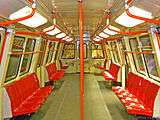 |
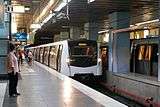 |
The Bombardier Movia 346 trains are made up of six permanently connected cars, forming an open corridor for the entire length of the train (2'2'+Bo'Bo'+Bo'Bo'+Bo'Bo'+Bo'Bo'+2'2' formation). Bombardier trains are used on all lines, except line M4. | 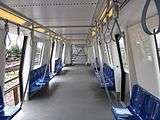 |
 |
In November 2011, Metrorex signed a €97 million contract with CAF for 16 metro trains (96 cars), with options for a further 8 sets (48 cars).[17] The 114m-long six-car trains will be assembled in Romania. They each accommodate up to 1,200 passengers and are made up of four powered and two trailer vehicles. As of November 2014, all trains have been delivered and all 16 of them entered in service. As the CAF trains enter service, all of the Bombardier stock will be moved for use on line M3, according to Metrorex's plans to replace all of the old Astra IVA stock on the entire network.
In November 2014, Metrorex signed an additional €47 million contract with CAF for 8 metro trains. As of 2018, 24 CAF trains are in use, exclusively on line M2. |
 |
The subway livery for Bucharest is either white with two yellow or red horizontal stripes below the window for the Astra trains, stainless steel with black and white for the Bombardier trains, or stainless steel with blue and white for the CAF trains.
All trains run on a 750 V DC third rail, or an overhead wire (in maintenance areas where a third rail would not be safe). Maximum speed on the system is 80 km/h (50 mph), although plans are to increase it to 100 km/h (60 mph) on M5, a new line currently under construction.
Facts
Bucharest Metro was the only one in the world that operated with passengers during probation.[18]
In the 1980s, the speed of building the network (4 kilometers / year) placed the BucharestMetro on the second place in the world, after Mexico City Metro.[19]
The shortest distance between two adjacent stations is between Gara de Nord 2 (M4) and Basarab 2 (M4) and is 430 meters.
Bucharest Metro was built with Romanian forces and resources. The countries that have succeeded this: Germany, France, United Kingdom, United States, Soviet Union, China and Romania. The effort was colossal for that moment.
See also
References
- 1 2 3 4 5 6 7 8 9 "Metrorex - Network features". Metrorex. Retrieved 2014-05-07.
- 1 2 3 "Metrorex - Map" (in Romanian). Metrorex. Retrieved 2014-05-07.
- 1 2 Bucharest Metro
- ↑ Călin Cociș (9 September 2015). "Topul stațiilor de metrou din București, după numărul de călători. Stația SURPRIZĂ de pe locul I". B365.
- 1 2 3 4 "Metrorex - Metrorex history". Metrorex. Retrieved 2014-05-08.
- 1 2 "30 de ani de exploatare a metroului bucurestean" (in Romanian). agir.ro. August 2009.
- ↑ "Metroul bucureştean, 10 lucruri pe care ar trebui să le cunoşti" (in Romanian). historia.ro. Retrieved 2014-07-29.
- ↑ "Bucureştiul mileniului trei imaginat în 1930" (in Romanian). cotidianul.ro. Retrieved 2014-07-29.
- 1 2 "Ce nu știați despre metroul bucureștean: De la planurile din 1909, la Magistrala 7" (in Romanian). 19 November 2012. Retrieved 2014-07-29.
- 1 2 3 4 Bucharest Metro at urbanrail.net
- ↑ "Istoric Metroul bucureştean" (in Romanian). metroubucuresti.webs.com. Archived from the original on 9 August 2014. Retrieved 29 July 2014.
- ↑ "Metrorex - Schedule". Metrorex. Retrieved 2014-05-07.
- ↑ "Metrorex - Fees". Metrorex. Retrieved 2014-05-07.
- ↑ "Bucuresti metro expansion tendering". Railway Gazette. 22 February 2011. Retrieved 2011-02-27.
- ↑ Vlad Ignat. "Păianjenul Metrorex schimbă harta Capitalei. Bucureştenii se mută în subteran, din 2030" [Metrorex's Web Project changes the map of Bucharest. Bucharest moves underground by 2030]. Adevărul (in Romanian). Retrieved 2014-05-07.
- ↑ În cele mai noi staţii de metrou vor circula cele mai vechi trenuri Metrorex (in Romanian)
- ↑ CAF Info cars
- ↑ "Metroul din Bucureşti, singurul din lume care a funcţionat cu călători în perioada de probe | Bucurestii Vechi si Noi". www.bucurestiivechisinoi.ro (in Romanian). Retrieved 2018-07-07.
- ↑ Juncu, Diana. "10 lucruri pe care nu le știai despre metroul bucureştean". OBSERVATOR.TV. Retrieved 2018-07-07.
External links
| Wikimedia Commons has media related to Bucharest Metro. |
- Metrorex - official site
- 2015 Activity Report
- Interactive subway map (in Romanian)
- Bucharest Metro Track Map (in Russian)
- Bucharest Metro Challenge
- Bucharest Subway info
- Bucharest Metro, practical map
- Map of future lines
- Bucharest Metro Map
